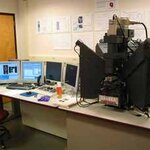Geology
Although it's been more than a year since Mount Augustine had its memorable eruption, work continues for University of Alaska Fairbanks researchers. The work of Alaska Volcano Observatory employees from UAF's Geophysical Institute will be appearing in the upcoming issue of the journal Science.
The article, which came out on Feb. 23, documents electrical activity that occurred during the January 2006 eruption of Mount Augustine. While it has long been known that volcanic eruptions can produce vigorous lightning, there are few direct observations of the phenomena, states the article. Following…

The Himalaya, the “Roof of the World”, source of the seven largest rivers of Asia are, like other mountain chains, suffering the effects of global warming. To assess the extent of melting of its 33 000 km2 of glaciers, scientists have been using a process they have been pioneering for some years. Satellite-imagery derived glacier surface topographies obtained at intervals of a few years were adjusted and compared. Calculations indicated that 915 km2 of Himalayan glaciers of the test region, Spiti/Lahaul (Himachal Pradesh, India) thinned by an annual average of 0.85 m between 1999 and 2004.…

Factoring in crustal strength changes along the San Andreas Fault would improve the predictive models that researchers use to understand the likelihood and intensity of earthquakes there. That's the conclusion from a study published in the April issue of Geology titled, "Diffuse interseismic deformation across the Pacific-North America plate boundary."
Currently, it is standard practice for universities and government agencies to measure crustal movement that occurs within Southern California using precise Global Positioning System (GPS) and other highly accurate tools that project…

People where I live still talk about the New Madrid earthquakes that occurred in southern Missouri in 1811 and 1812. I've heard that church bells rang hundreds of miles away in New England, disturbed by the seismic waves, and supposedly the surface of the earth subsided as a result of the quakes to such a degree that it created a new lake (Reelfoot Lake in Tennessee). The aftershocks go on to this day.
I spent part of my childhood in southern California and grew up with the instructions about standing in a door jamb during a quake and all that, so I was used to the idea of California as…
After years of results that repeatedly dogged him, University of Oregon geologist Douglas R. Toomey decided to follow the trail of data surfacing from the Pacific Ocean. In doing so, he and his collaborators may have altered long-held assumptions involving plate tectonics on the ocean floor.
Reporting in the March 22 issue of Nature, Toomey and co-authors from four other institutions propose that, one, the flow in the Earth's mantle is rotated beneath the East Pacific Rise, causing the plate boundary to change orientation with time. Secondly, they argue that deep-sea hydrothermal vents…

Assigning dates to the events in the life of a rock—for example, a collision with a piece of continent, or a journey through the Earth’s crust—has long challenged geologists, as the events themselves can confound evidence of the past.
But now, armed with a custom-built machine known as the Ultrachron, University of Massachusetts Amherst scientists are refining a technique that allows them to pin dates to geologic processes with unprecedented precision. The research is already providing new information on the expansion of the North American continent and the growth of the Himalayas, and…

At a depth of 2900 kilometres, the layer between the Earth's mantle and its core has always intrigued geophysicists because they are unable to explain the seismic data it generates. Researchers in the Solid State Structure and Properties Laboratory (CNRS/Université Lille 1/Lille National School for Advanced Chemistry) have studied its deformation which influences convection movements within the mantle or even those by tectonic plates. Despite the inaccessibility of this layer and the extreme conditions which prevail, they have succeeded in modelling the defects responsible for its…
Researchers at Rensselaer Polytechnic Institute have discovered what likely triggered the eruption of a "supervolcano" that coated much of the western half of the United States with ash fallout 760,000 years ago.
Using a new technique developed at Rensselaer, the team determined that there was a massive injection of hot magma underneath the surface of what is now the Long Valley Caldera in California some time within 100 years of the gigantic volcano’s eruption. The findings suggest that this introduction of hot melt led to the immense eruption that formed one of the world’s largest…

Cardiff University scientists will shortly set sail (March 5) to investigate a startling discovery in the depths of the Atlantic.
Scientists have discovered a large area thousands of square kilometres in extent in the middle of the Atlantic where the Earth's crust appears to be missing. Instead, the mantle - the deep interior of the Earth, normally covered by crust many kilometres thick - is exposed on the seafloor, 3000m below the surface.
Marine geologist Dr Chris MacLeod, School of Earth, Ocean and Planetary Sciences said: "This discovery is like an open wound on the surface of the Earth…
A 17-year University of Utah study of ground movements shows that the power of the huge volcanic hotspot beneath Yellowstone National Park is much greater than previously thought during times when the giant volcano is slumbering.
Wyoming's Teton Range looms behind a Global Positioning System (GPS) antenna in Jackson Hole that was part of a 17-year University of Utah study in which GPS devices were used to measure gradual movements of Earth's crust in Grand Teton National Park, Yellowstone National Park and surrounding areas. The study found the Teton Range and Jackson Hole are moving in…